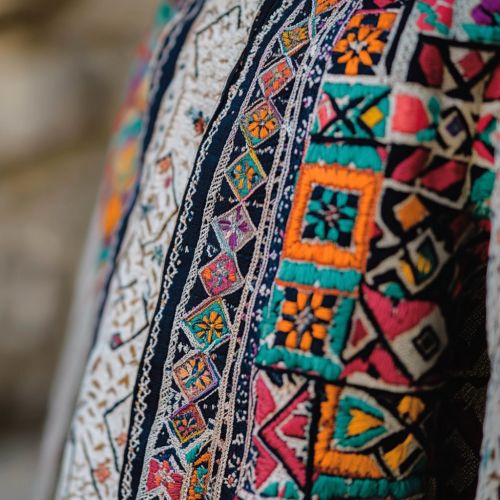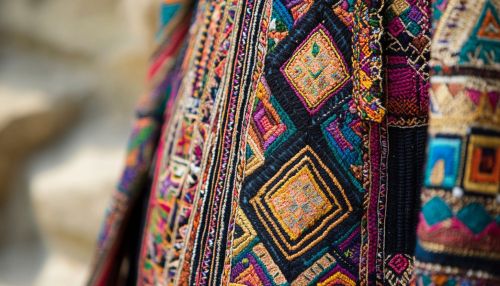Tatreez
Introduction
Tatreez, also known as Palestinian embroidery, is a traditional form of embroidery that has been practiced for centuries in the region of Palestine. It is a significant cultural expression, often used to decorate clothing, accessories, and household items. Tatreez is characterized by its intricate geometric patterns and vibrant colors, each of which carries specific meanings and stories. This article delves into the history, techniques, cultural significance, and contemporary relevance of Tatreez.
Historical Background
Tatreez has its roots in ancient Palestine, with evidence of embroidery found in archaeological sites dating back to the Iron Age. Historically, Tatreez was a skill passed down through generations of women, serving as a form of storytelling and cultural preservation. The patterns and motifs used in Tatreez were often specific to particular villages or regions, allowing individuals to identify the origin of a piece of embroidery.
During the Ottoman Empire, Tatreez flourished as a form of artistic expression, with influences from neighboring cultures enriching its designs. The embroidery was not only a decorative art but also a means of documenting personal and communal histories. Women would often incorporate symbols representing their life experiences, social status, and aspirations into their work.
Techniques and Materials
Tatreez is traditionally created using a needle and thread on a fabric base, typically linen or cotton. The embroidery is executed using a variety of stitches, with the cross-stitch being the most prevalent. This technique allows for the creation of detailed and symmetrical patterns.
The threads used in Tatreez are usually made from silk or cotton and are dyed in vibrant colors using natural dyes derived from plants and minerals. Common colors include red, blue, green, and black, each symbolizing different aspects of life and nature. For instance, red often represents love and strength, while blue symbolizes protection and peace.


Patterns and Symbolism
The patterns in Tatreez are rich with symbolism and vary widely across different regions. Common motifs include the cypress tree, which symbolizes eternity and life; the moon, representing femininity and fertility; and the star, signifying guidance and protection. Each pattern tells a story, often reflecting the embroiderer's personal experiences and cultural heritage.
In addition to individual motifs, Tatreez patterns are often arranged in complex geometric designs. These designs can include rows of repeating motifs, intricate borders, and central medallions. The arrangement of patterns is carefully planned to create a harmonious and aesthetically pleasing composition.
Cultural Significance
Tatreez holds deep cultural significance for Palestinians, serving as a symbol of identity and resilience. It is an integral part of traditional Palestinian dress, particularly the thobe, a long robe worn by women. The embroidery on a thobe can indicate the wearer's marital status, social standing, and regional origin.
In addition to its role in clothing, Tatreez is used to adorn a variety of household items, such as cushions, tablecloths, and wall hangings. These embroidered items are often passed down as family heirlooms, preserving the stories and traditions of previous generations.
Tatreez also plays a role in social and communal activities. Women often gather in groups to work on embroidery projects, sharing stories and strengthening community bonds. These gatherings provide a space for cultural exchange and the transmission of traditional knowledge.
Contemporary Relevance
In recent years, Tatreez has experienced a resurgence in popularity, both within Palestine and internationally. This renewed interest is driven by a desire to preserve and promote Palestinian cultural heritage in the face of political and social challenges. Many contemporary designers incorporate Tatreez into modern fashion, creating a fusion of traditional and contemporary styles.
Tatreez has also become a form of cultural diplomacy, with exhibitions and workshops held worldwide to showcase the art form and educate audiences about Palestinian culture. These initiatives aim to foster cross-cultural understanding and appreciation for the rich history and artistry of Tatreez.
Challenges and Preservation Efforts
Despite its cultural significance, Tatreez faces challenges in the modern world. The displacement of Palestinian communities and the loss of traditional knowledge pose threats to the continuity of this art form. Additionally, the rise of mass-produced embroidery and imitation products undermines the value of authentic Tatreez.
Efforts to preserve Tatreez include documentation projects, educational programs, and support for local artisans. Organizations and individuals are working to record traditional patterns and techniques, ensuring that this knowledge is accessible to future generations. Workshops and training programs are also being established to teach young people the skills needed to continue the tradition of Tatreez.
